Fontevraud-l’Abbaye to Saumur
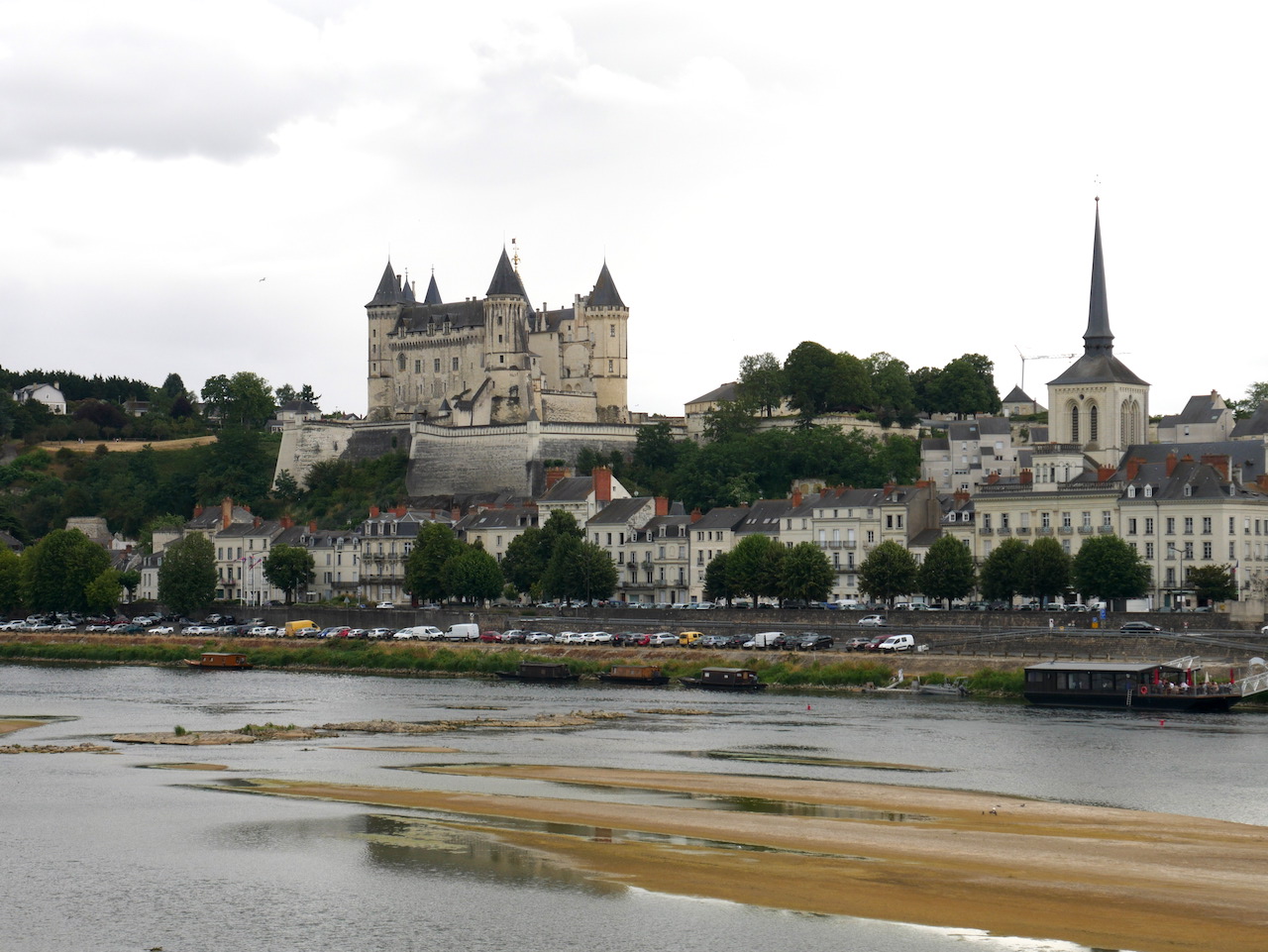
Pays de la Loire
12. Fontevraud-l’Abbaye to Saumur
Medium
7h
26,8km
+368m
-408m
Step
Embed this item to access it offline
From Fontevraud-l'Abbaye you go up into the forest, a beautiful panorama of the abbey awaits you, quickly you cross the cereal crops to visit Candes-Saint-Martin. The Saumur vineyard accompanies you to Saumur, the castle of the town is in sight you go down into the town centre to discover the churches and the cavalry school which made the reputation of the town to end your day in front of the remains of the monastery Saint-Florent.
11 points of interest
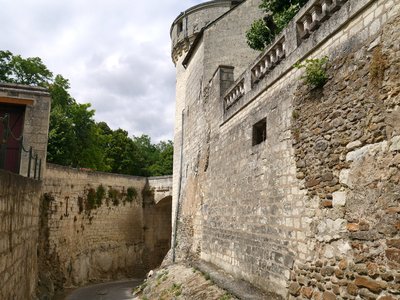
Douves des remparts de Candes-Saint-Martin - Amis saint Colomban HistoricalRamparts of Candes-Saint-Martin
The name of Candes comes from the Latin Condate, confluence of the Vienne and Loire rivers, a strategic location that was fortified as early as the Middle Ages. You can admire part of the old ramparts and moats. The city has many old houses.
Église paroissiale de Candes-Saint-Martin et la Via Columbani - Amis saint Colomban TouristSaint Martin's Collegiate Church in Candes-Saint-Martin
A first church, dedicated to Saint Maurice, was built by Saint Martin in one of the first rural Touraine parishes he founded and where he died in 397. It later became a pilgrimage church, even in the absence of the saint's relics. In 1050, the church of Candes is mentioned as "collegiate" and its chapter has twelve canons.
The old church of Saint-Maurice being ruined, the present church of Saint-Martin de Candes was built between 1175 and the middle of the 13th century. The addition, in the 15th century after the Hundred Years' War, of features making this collegiate church one of the few fortified churches in Touraine, reinforces its singularity. It is considered to be "the second most beautiful religious building in Indre-et-Loire after Saint-Gatien Cathedral in Tours".
St. Martin, on a trip to Candes where he came to settle a dispute between religious of his diocese, St. Martin, weakened by age - he was 81 years old at the time - died on November 8, 397. His mortuary house, a place of pilgrimage from the 5th century onwards, seems to have survived until the 12th century. The church he dedicated to Saint Maurice, in which pilgrims came to celebrate his cult, still exists at the same time. Until the middle of the 9th century, the church was served by the monks of a priory also founded by Martin. It was only afterwards that they were replaced by a college of twelve canons, attested around 1050, and the church of Saint-Maurice was raised to the rank of collegiate church at the same time.
Château de Montsoreau en bord de Loire - Amis saint Colomban HistoricalMontsoreau Castle
Built on a rocky promontory in front of the Loire, immediately at the confluence of the Loire and the Vienne rivers, it is at the intersection of three regions (Anjou, Poitou and Touraine), in the heart of the Loire Valley.
The first written mention of the site being occupied by the estate of Restis dates from the 6th century. It was transformed into a stronghold around 990 by the Count of Blois Eudes 1st.
The current castle lays its foundations on a rocky outcrop on the banks of the Loire. Built in 1450 by one of the richest men of the kingdom, John II of Chambes, first advisor to the Kings of France Charles VII and Louis XI, ambassador to Venice and associate of Jacques Coeur.
More details: Wikipedia
To visit the castle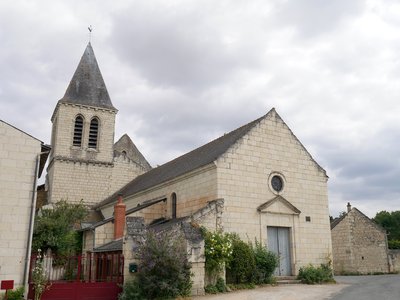
Église Saint-Aubin de Turquant - Amis saint Colomban TouristSaint-Aubin Church in Turquant
The presence of the church of Turquant is attested to as early as the middle of the 12th century when its construction began, with most of the building dating from the 15th and 16th centuries.
At the end of the 17th century, a reconstruction was carried out to restore the bell tower which had collapsed. At the beginning of the 2000s, work was undertaken to bring it up to standard and restore the foundations, the framework and part of the roof.
In the choir two high reliefs in polychrome wood from the 18th century are of remarkable workmanship and are worth a visit. Each represents a scene from the crucifixion, which is described on an information panel in the building.
Église saint-Pierre de Parnay - Amis saint Colomban TouristSaint-Pierre Church in Parnay
The church is closed.
Situated on the banks of the Via Columbani, the church of Saint-Pierre is outside Parnay on the edge of the hillside overlooking the Loire.
In the 11th century it was part of the domain of the bishopric of Angers. It belonged to Canon Rainard who, with the consent of Bishop Geoffroy, donated it to the Abbey of Saint-Aubin d'Angers in 1089.
It later passed to the patronage of the cathedral church of Poitiers, whose chapter received two thirds of the tithes, leaving the other third to the parish priest.
In September 1587, the Huguenots occupied the parish for a fortnight, as Gilles Mauxion, the parish priest at the time, pointed out.
The church of Saint-Pierre de Parnay seems to have a complicated architectural past with a 12th century bell tower in front of the choir. In the southern corner, a 15th-16th century staircase turret is attached to the Romanesque bell tower.
Inside, the nave, rebuilt in the 19th century, communicates with the aisles through semicircular arcades that rest on cylindrical pillars whose capitals, decorated with water leaves or roughly carved animals, are the only witnesses of the 11th century church.
The Gothic choir was built in the 15th century, as was the polygonal apse, which is illuminated by two flamboyant lattice windows and covered by a seven-branch vault.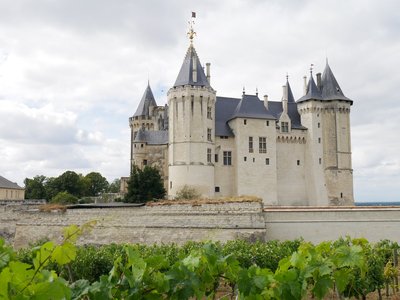
Château de Saumur, vue depuis la Via Columbani - Amis saint Colomban HistoricalCastle of Saumur
Possession of the Counts of Anjou and then of the Plantagenets, it was transformed into a royal fortress at the beginning of the 13th century at the time of King Saint Louis. During the second half of the 14th century, Duke Louis I of Anjou (brother of King Charles V) transformed it into a sumptuous castle-palace.
Until the end of the Ancien Régime, the building served as the residence of the various governors of the city. The best known of them, Philippe Duplessis-Mornay was appointed in 1589. The town of Saumur has just been conceded to the Protestant party as a place of safety. The new governor had the castle fortified by the wall that still exists, of a very innovative design for its time (the part on the side of the city was built nearly a century before Vauban's works!).
During the 17th and 18th centuries, the castle of Saumur was also used as a prison: prisoners on letter of seal then from the 1780s prisoners of war (mainly British sailors).
The building is spared by the Revolution. It was saved from the destruction to which its poor condition was doomed by the decision of Napoleon I to transform it into a state prison.
Major works were carried out to adapt it to its future use. But the political change linked to the Restoration of the Monarchy changed its destiny once again. In 1814 it was assigned to the Ministry of War and became an arms and ammunition depot.
The town became the owner of the castle in 1906, from that date on several restoration campaigns will follow one another.
More information: Wikipedia
To visit the castle of Saumur : Saumur Tourist Office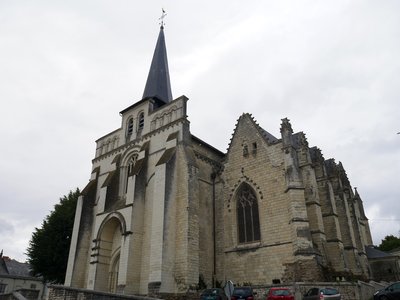
Façade de l’église Notre-Dame de Nantilly à Saumur - Amis saint Colomban TouristNotre-Dame de Nantilly Church in Saumur
The church of Notre-Dame de Saumur is the oldest church in the city. The Romanesque nave, built at the end of the 11th century, and the 12th century choir have historiated capitals.
The collateral wing situated to the south, in flamboyant gothic style, was built in the 15th century by the king of France Louis XI who liked to come and pray there.
In the apse, to the right of the choir, there is a 12th century polychrome wooden statue of the Virgin with the baby Jesus, representing Notre-Dame de Nantilly.
The church has a collection of medieval tapestries from the 15th and 16th centuries as well as Aubusson tapestries from the 17th century.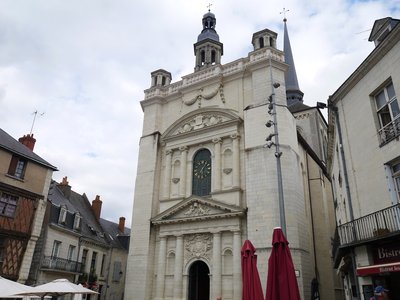
Façade de l’église Saint-Pierre de Saumur dans la vieille ville - Amis saint Colomban TouristSaint Peter's Church in Saumur
A mention in the Chronicle of Saint-Maixent suggests that a Saint-Pierre church existed déjà̀ in 1067 or 1068 and belonged then to the powerful neighbouring abbey of Saint-Florent.
The monument we see today is built at the turn of the 12th and 13th centuries, on an embankment à at the foot of the hillside, which sheltered it from the floods of the Loire. During the French Revolution, the church was used as a public hall, hall and warehouse. It was given back to worship in 1800 and was erected as a parish church in 1802. The churches of Nantilly, Saint-Nicolas and de la Visitation on the Ile d'Offard became branches.
The church of Saint-Pierre has been the subject of major restoration campaigns over the centuries, mainly due to the fact that it was built on unstable ground.
The first major work brought to our attention was undertaken in the 17th century, after the collapse of the Gothic facade in 1674.
On the outside, the chevet, the arms of the transept and the powerful crossing bell tower are in Romanesque style. The chevet has a protruding apse and two apsidioles on the crossbars, a common plan in Anjou in the 12th century.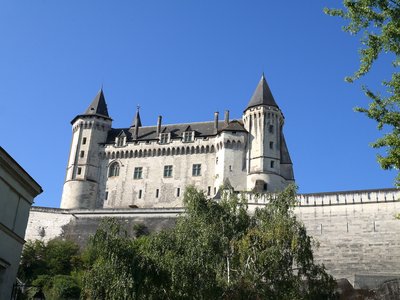
L’académie protestante était au pied du château de Saumur - Amis saint Colomban TouristThe Protestant Academy of Saumur
The Protestant Academy of Saumur was founded at the turn of the 16th and 17th centuries by Philippe Duplessy-Mornay. This institution was to play a fundamental role in the history of Calvinism before its closure in 1685.
In March 1593, he obtained permission from Henri IV to create such an establishment. His model is the Geneva Academy founded by Calvin in 1559. The Academy was set up behind the present town hall. Until 1620 the funding was based on royal subsidies obtained by the Reformed Churches of France under the Edict of Nantes.
After 1620 the financial difficulties increase until the crisis at the end of the Edict regime.
For 72 years nineteen foreigners taught in Saumur, fifteen Scots, two Dutch, one German, one Swiss.
More information: Wikipedia
L’école de cavalerie de Saumur - Amis saint Colomban HistoricalSaumur Cavalry School
In 1763, as part of the reorganisation of the French cavalry by the Duke of Choiseul, two brigades of the Carabinieri regiment of the Count of Provence settled in Saumur.
The construction on the spot of an exemplary cavalry school, intended to instruct the best officers and non-commissioned officers instructors is decided on May 1st 1765. The work continued with the construction of a covered arena in 1764-1765, stables in 1766 and 1768, and the central building of the cavalry school in 1768-1769.
The troops moved into the central building of the carabinieri barracks in 1770.
From 1771, it became the only training centre for military cavalrymen, replacing the five schools created in 1763 (Douai, Metz, Besançon, Cambrai and a brigade of the Royal Carabinieri in Angers).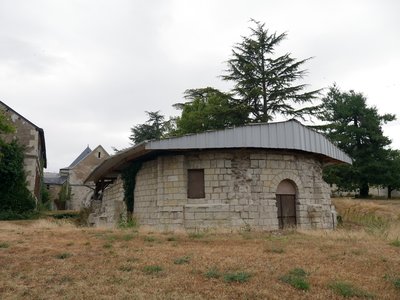
Vestiges de la crypte de l’abbatiale Saint-Florent - Amis saint Colomban TouristSaint Bartholomew's Church in Saint-Florent l'Abbaye
One could not talk about the church of Saint Barthélémy without first mentioning the abbey of Saint-Florent-de-Saumur, a vast architectural ensemble in which it was integrated and of which it is today one of the rare testimonies.
In the year 270 AD, under Emperor Maximilian, Florent, a Bavarian serving in the Roman Legions, was arrested on the Danube and promised martyrdom. He was miraculously freed from his bonds and guided to France to present himself to the great Saint Martin. The latter prepares him, confers the priesthood on him and sends him to Christianize the Lower Loire. It was around 360 that he reached Mont Glone (Saint Florent le Vieil) and settled there as a hermit. His reputation for holiness, accompanied by miracles, attracted pilgrims and brothers to Mont Glone.
In 866, the Normans of Hasting took Mont Glone. The monks were forced to flee to Burgundy, taking with them the reliquary of their holy founder. Once the Norman danger was averted, the monks deposited the relics in 956 in the enclosure of the "castrum de Saumur" built by Thibault le Tricheur, Count of Biais.
The count generously helps the monks to build a new abbey. The work on the abbey church was completed between 1128 and 1159 and many conventual buildings, such as the chapter house, the parlour and the refectory were started.
But the Hundred Years' War broke the expansion of what was then called "La Belle d'Anjou".
New restoration work was undertaken, including the Saint-Barthélemy chapel located on the monastery grounds. During the Revolution, the abbey was destroyed and only the parish church of Saint-Barthélemy remained.
Description
Leave the Place Saint-Michel by taking the rue de Rochechouart, second street on the right, rue Saint-Mainboeuf, after the bridge over the Arceau, straight on the path that goes up into the forest, direction Panorama.
- At the crossroads on the left, out of the woods first road on the right in the cereal fields, on the left, at the crossroads tarred road, on the left, cross D7
- Arriving in Candes-Saint-Martin by the rue du Panorama, on the right, rue Trochet, after a right turn, rue Saint-Maurice on the left, in front of the collegiate church on the left, rue de Compostelle
- At the roundabout, first street on the left, rue des Diligences, on the right, rue Jeanne d'Arc, place des Diligences, on the left, Haute Rue, rue André Obey, cross the rue des Abbesses, rue de l'église, in front of the church on the left, rue des Mazières, on the right rue des Moulins
- Exit Montsoreau, after the wine estate on your left and at the crossroads of the vineyard paths, straight ahead on the dirt road, second road on the right, on the left La Grande Vignolle, impasse Marguerite d'Anjou, on the left, rue de la Vignole
- Crossroads of Turquant on the left, rue des Martyrs, first on the right, rue de la Mairie, rue de Château-Gaillard, at the crossroads straight ahead, route de Turquant, first street on the left, impasse des Ducs d'Anjou,
- Take stairs on the left, impasse du Haut Midi in the vineyards, second vineyard path on the right, second path on the right, left in the wood, left, ruelle des Bideaux, left, rue Valbrun, after junction with chemin du Fort des Cours, take a dirt road between private property. Go along the vineyard by the right and straight ahead.
- Right, Chemin de Béniquet, left Haute Rue, go around the church, Haute Rue, rue Antoine Cristal, right dirt road between the vineyards, first road on the left, entrance of the wood on the right in the vineyards, left at the crossroads of dirt roads, cross D 205
- Left and right in the vineyards then the forest, straight ahead, after the lime kilns, Chemin des quatre Vents, second road on the left, left crossroads tarred road, straight ahead at the crossroads, Croix Blanche, rue Gaillarde, rue du Clos Thimeau, chemin de Tyreau, right junction route de Champigny D145
- Third on the right, rue des Moulins at the roundabout straight ahead, avenue du Docteur Peton, Anjou roundabout second on the right, rue des Remparts, go down towards Saumur town centre, cross the car park take the stairs on the right, rue du Fort, on the left, rue des Patenôtriers, on the right place Saint-Pierre
- Cross the square, rue de la tonnelle on the left, rue du Puit Neuf, on the left, rue Saint-Jean, on the right, rue Franklin Roosevelt, on the left, rue de la Petite Bilange, rue du Pavillon, on the left, rue du Colonel Michon, cross place Charles de Foucauld
- Turn right Avenue du Maréchal Foch, at the roundabout take the second street on the right, rue des Maréchaux, at the roundabout go around the shopping centre by the right, do not cross the river continue going up, on the left, rue Georges Pompidou, roundabout of the abbey, second street on the left, rue de la Sénatorerie, on the right place of the Saint-Barthélemy church, you have arrived.
- Departure : Saint Michael's Church, place Saint-Michel, 49590 Fontevraud-l’Abbaye
- Arrival : Saint-Barthélemy Church, 2 place Jeanne d'Arc, St-Hilaire-St-Florent, 49400 Saumur
- Towns crossed : Pays de la Loire and Centre-Val de Loire
Altimetric profile
Transport
Gare SNCF Saumur
Avenue David d'Angers
49400 Saumur
Report a problem or an error
If you have found an error on this page or if you have noticed any problems during your hike, please report them to us here:








